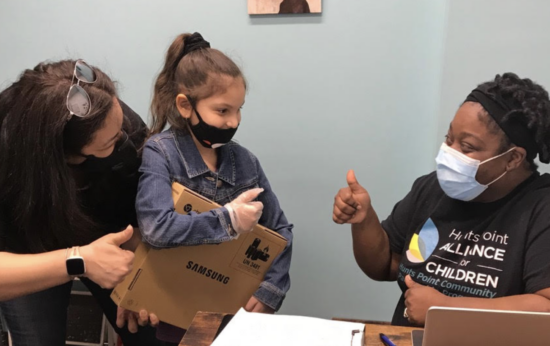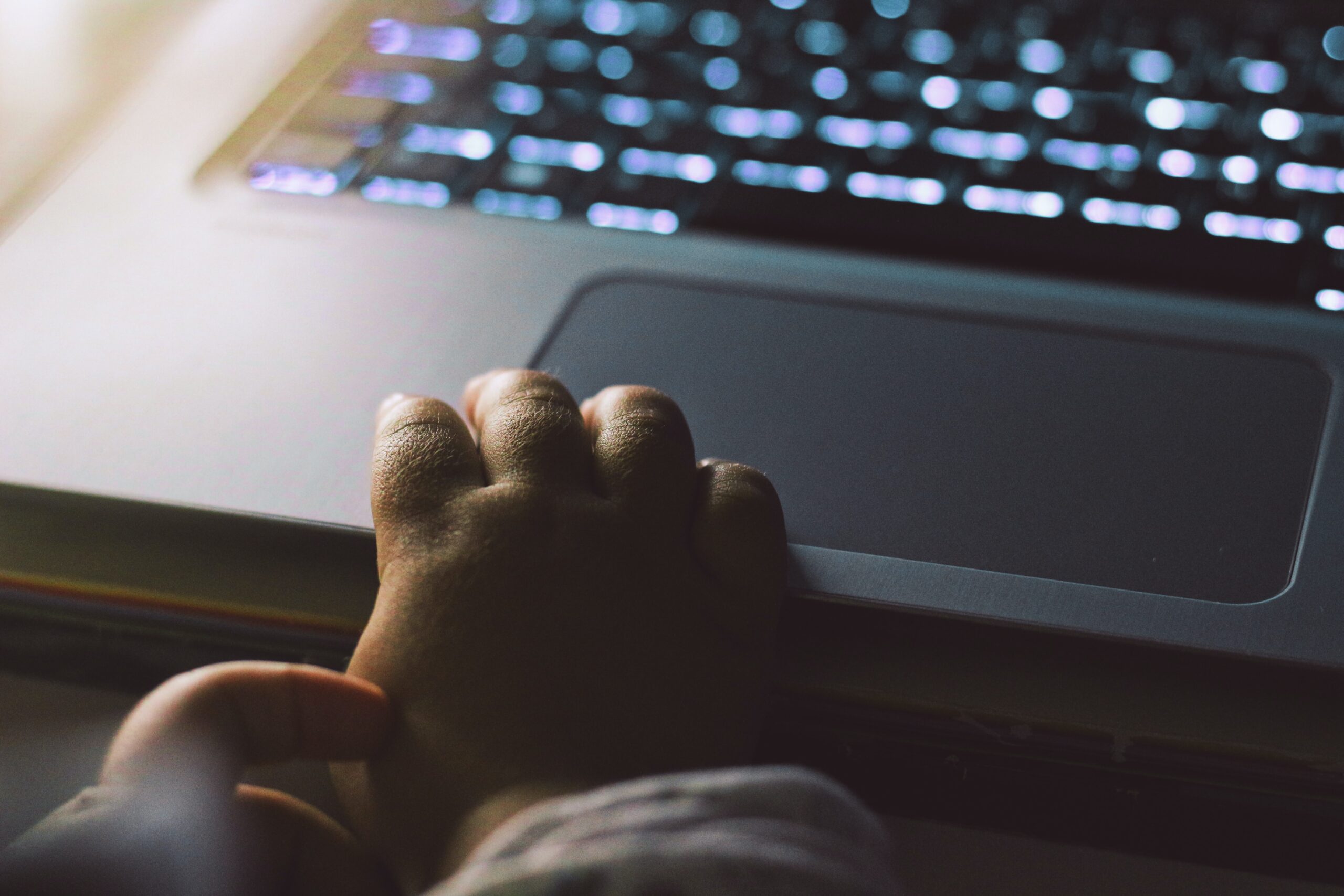
It’s been a year since the COVID-19 pandemic swept across New York, shuttering schools and uprooting in-person instruction. Yet thousands of students across the South Bronx still don’t have access to reliable internet and a device that makes remote learning possible.
“A lot of families don’t have great Wi-Fi even if they do have Wi-Fi. It’s not perfect by far,” said Rich Darrell, principal of Hunts Point Catholic school St. Ignatius, located on Manida Street. “Our students are just not students at home. They watch their siblings, they do stuff for their families, and when families have to survive, education goes down on that list of survival. Food, shelter, heat — those things rise to the top so the inequities throughout this pandemic have hit all of our South Bronx families.”
While the complexities of remote learning have underscored the importance of returning to in-person learning, students at the Catholic middle school were still fortunate, Darrell said. Due to the private school’s donors and access to resources, each student left school last March with a Chromebook and a hotspot if they didn’t already have internet access.
Many South Bronx students didn’t get this opportunity.
A digital divide has persisted in the South Bronx for decades — an issue that has only been exacerbated by the pandemic as the digital realm has become increasingly important to conducting day-to-day life. But while these inequities persist in communities like Hunts Point, local leaders, nonprofits and educators are working hard to address the digital divide in their community, advocating for lasting change and bringing relief to their neighborhoods.
Not an isolated problem
City-wide, about one-fifth of New Yorkers lack home and mobile broadband internet service and 40% of residents have access to only one of the two, according to New York City’s recently released Internet Master Plan. This plan says about 45% of low-income families don’t have a connection, including 100,000 students who live in homes without internet.
While elementary and middle schools in New York City have resumed some in-person instruction, with high schoolers set to return on March 22, hundreds of thousands of students have opted to continue remote learning.
Hunts Point and Mott Haven are classified as having “low” home and mobile broadband connection, meaning just 34%-54% of households have a home and mobile broadband subscription, according to the Internet Master Plan.
The digital divide has been one of the most difficult challenges students have faced throughout the pandemic, said Jill Roche Gomez, Hunts Point Alliance for Children executive director.
Some students drift in and out of online classes on a parent’s cell phone while others may have received a device from the Department of Education, yet due to a poor connection, they still struggle to participate, Gomez said. Other students, many of whom live in temporary housing, just aren’t showing up to classes.
She said the South Bronx’s lack of access to Wi-Fi boils down to a structural issue that can only be solved through regulation, federal and local policy and viewing access to broadband as a utility — not something that’s optional.
“You have companies that I’m sure are doing their best to reach the highest number of consumer base but without regulation, we are treating it as something that is nice to have and not something that is required in order for students to be really ready to compete in the careers of right now,” Gomez said.
Simply making sure every student has a connection is not necessarily addressing the problem either, Gomez said, explaining that while some children do have Wi-Fi in their homes, it’s often not reliable and doesn’t allow them to “meaningfully participate” in remote learning due to frequent disconnection or the need to keep their cameras turned off because it uses less bandwidth.
Community tries to bridge the gap
Hunts Point Community Partnership, led by Shamekia Gordon, has been working with New York State Sen. Alessandra Biaggi, who represents a swath of Hunts Point, to keep a list of students in the community who have yet to receive a device. They are also working to raise money to purchase additional laptops.
Hunts Point Community Partnership is also advocating for students to be able to keep the devices over the summer and even after in-person instruction resumes.
“It’s a huge capital investment, but I think when you are leveraging philoprantic dollars and using capital funding, you need to be cognizant of the fact that this is a once in a lifetime moment and the downside of not getting students the laptops either quickly enough or letting them keep them, can have really devastating effects,” Gomez said.
The devices give students the chance to connect with others, complete homework and access additional resources, she explained. “It used to be access to textbooks — this is not new, it’s just that laptops or devices are the new instructional delivery method.”
Hunts Point Community Partnership isn’t the only South Bronx group giving students a device — many lawmakers and other organizations like the Bronx Community Relief Effort, which has distributed over 2,000 chromebooks and hotspots, are doing the same.
But the issue of the digital divide is far more complicated than allocating laptops and i-Pads, which is why a coalition of Bronx-based organizations and individuals are working to identify and address the underlying issues.
A Bronx digital equity coalition takes shape
“Historically speaking, companies have come into the Bronx and really told us what we need. The reality is that hasn’t really moved the prosperity needle,” said Derrick Lewis, co-founder and chair of The Bronx Community Relief Effort.
“The time is now for the Bronx to come together to decide what the Bronx needs and then apply requirements and criteria to organizations that want to come into the Bronx to provide services and resources that align with what we believe we need as a community.”
Lewis and his brother Desmon have been working to address the digital divide in the Bronx for the past year, first through the The Bronx Community Foundation and now with the formation of the Bronx Digital Equity Coalition.
The coalition of organizations and community leaders, still being formed as an official entity, has been meeting for months to begin thinking about strategies to close the digital divide in the Bronx, including ways to provide digital literacy training, get broadband and Wi-Fi access into the homes of residents, and provide workforce development training.
Action is needed now, he said. “We aren’t trying to wait two or three months — the focus should be to do it now.”
Mariel Charles, collective impact manager overseeing the K-12 work of South Bronx Rising Together, is co-spearheading a working group within the coalition specifically for education.
The working group is focusing on ensuring quality education for students throughout remote learning, particularly multilingual learners, students with special needs, and students living in temporary housing, all of whom face additional obstacles.
Training teachers and parents how to better use the digital devices are all key to providing “a more comprehensive approach to the digital divide,” Charles said.
South Bronx Rising Together wrote a letter in December addressed to New York City Mayor Bill de Blasio and then-Education Chancellor Richard Carranza, calling on the city to provide digital devices to all students immediately and to hold internet service providers accountable. Since then, the coalition has gathered more information to add nuance.
What now?
The coalition, Charles said, has been communicating with political leaders, the Department of Education and internet service providers throughout the process and expects to get agreement soon on next steps.
Beyond device distribution and tech assistance, she said, the group is also focusing on the quality of remote education and holding internet service providers accountable — measures that will have impact for years into the future.
“Oftentimes when people think ‘digital divide’ they think, ‘oh students don’t have a laptop,” Charles said. “It really takes some adaptive level conversations to really enact the change that can best support families. If lack of laptops could solve education issues it would be an easy fix.”

